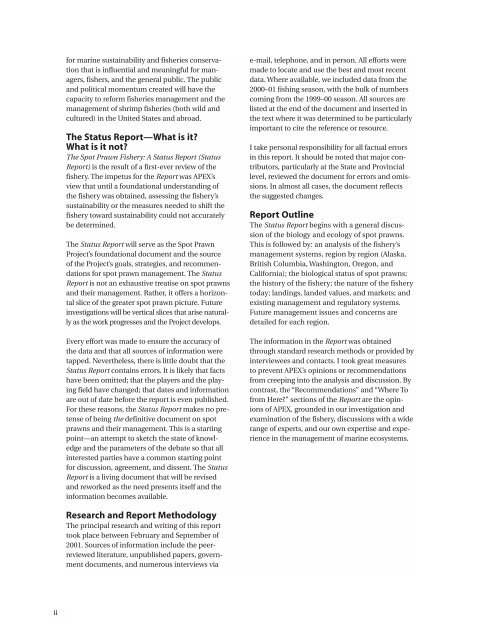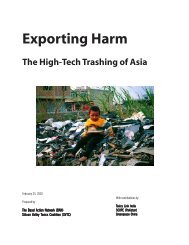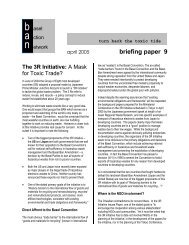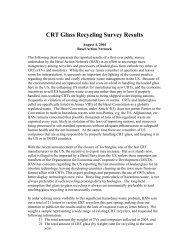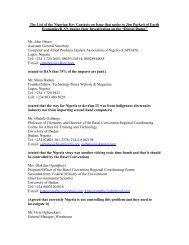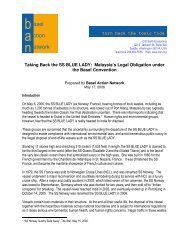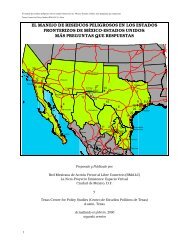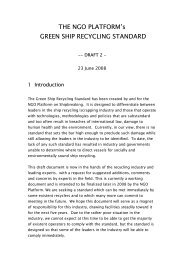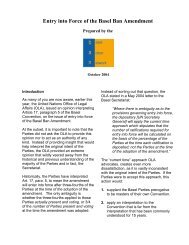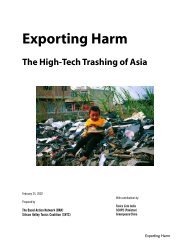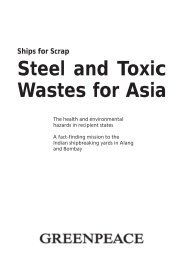The Spot Prawn Fishery The Spot Prawn Fishery - Basel Action ...
The Spot Prawn Fishery The Spot Prawn Fishery - Basel Action ...
The Spot Prawn Fishery The Spot Prawn Fishery - Basel Action ...
You also want an ePaper? Increase the reach of your titles
YUMPU automatically turns print PDFs into web optimized ePapers that Google loves.
ii<br />
for marine sustainability and fisheries conservation<br />
that is influential and meaningful for managers,<br />
fishers, and the general public. <strong>The</strong> public<br />
and political momentum created will have the<br />
capacity to reform fisheries management and the<br />
management of shrimp fisheries (both wild and<br />
cultured) in the United States and abroad.<br />
<strong>The</strong> Status Report—What is it?<br />
What is it not?<br />
<strong>The</strong> <strong>Spot</strong> <strong>Prawn</strong> <strong>Fishery</strong>: A Status Report (Status<br />
Report) is the result of a first-ever review of the<br />
fishery. <strong>The</strong> impetus for the Report was APEX’s<br />
view that until a foundational understanding of<br />
the fishery was obtained, assessing the fishery’s<br />
sustainability or the measures needed to shift the<br />
fishery toward sustainability could not accurately<br />
be determined.<br />
<strong>The</strong> Status Report will serve as the <strong>Spot</strong> <strong>Prawn</strong><br />
Project’s foundational document and the source<br />
of the Project’s goals, strategies, and recommendations<br />
for spot prawn management. <strong>The</strong> Status<br />
Report is not an exhaustive treatise on spot prawns<br />
and their management. Rather, it offers a horizontal<br />
slice of the greater spot prawn picture. Future<br />
investigations will be vertical slices that arise naturally<br />
as the work progresses and the Project develops.<br />
Every effort was made to ensure the accuracy of<br />
the data and that all sources of information were<br />
tapped. Nevertheless, there is little doubt that the<br />
Status Report contains errors. It is likely that facts<br />
have been omitted; that the players and the playing<br />
field have changed; that dates and information<br />
are out of date before the report is even published.<br />
For these reasons, the Status Report makes no pretense<br />
of being the definitive document on spot<br />
prawns and their management. This is a starting<br />
point—an attempt to sketch the state of knowledge<br />
and the parameters of the debate so that all<br />
interested parties have a common starting point<br />
for discussion, agreement, and dissent. <strong>The</strong> Status<br />
Report is a living document that will be revised<br />
and reworked as the need presents itself and the<br />
information becomes available.<br />
Research and Report Methodology<br />
<strong>The</strong> principal research and writing of this report<br />
took place between February and September of<br />
2001. Sources of information include the peerreviewed<br />
literature, unpublished papers, government<br />
documents, and numerous interviews via<br />
e-mail, telephone, and in person. All efforts were<br />
made to locate and use the best and most recent<br />
data. Where available, we included data from the<br />
2000–01 fishing season, with the bulk of numbers<br />
coming from the 1999–00 season. All sources are<br />
listed at the end of the document and inserted in<br />
the text where it was determined to be particularly<br />
important to cite the reference or resource.<br />
I take personal responsibility for all factual errors<br />
in this report. It should be noted that major contributors,<br />
particularly at the State and Provincial<br />
level, reviewed the document for errors and omissions.<br />
In almost all cases, the document reflects<br />
the suggested changes.<br />
Report Outline<br />
<strong>The</strong> Status Report begins with a general discussion<br />
of the biology and ecology of spot prawns.<br />
This is followed by: an analysis of the fishery’s<br />
management systems, region by region (Alaska,<br />
British Columbia, Washington, Oregon, and<br />
California); the biological status of spot prawns;<br />
the history of the fishery; the nature of the fishery<br />
today; landings, landed values, and markets; and<br />
existing management and regulatory systems.<br />
Future management issues and concerns are<br />
detailed for each region.<br />
<strong>The</strong> information in the Report was obtained<br />
through standard research methods or provided by<br />
interviewees and contacts. I took great measures<br />
to prevent APEX’s opinions or recommendations<br />
from creeping into the analysis and discussion. By<br />
contrast, the “Recommendations” and “Where To<br />
from Here?” sections of the Report are the opinions<br />
of APEX, grounded in our investigation and<br />
examination of the fishery, discussions with a wide<br />
range of experts, and our own expertise and experience<br />
in the management of marine ecosystems.


